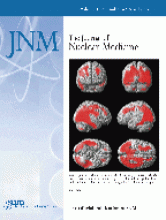In the review of the literature for our paper (1), we overlooked the report by Hilditch et al. (2). We regret this omission.
The letter by Hilditch et al. makes a case for some stunning effects from diagnostic doses of 131I. However, points in the letter and in their paper (2) leave uncertainties.
Several differences in methods may have contributed to the differences between our results and those of Hilditch et al. We administered therapeutic 131I immediately after the last measurements of diagnostic radioiodine. In the Hilditch communication, there was an interval of 3–38 d between the end of diagnostic testing and ingestion of the therapeutic dose of 131I. The effects of prolonged stimulation by thyroid-stimulating hormone are unknown. For diagnostic 131I, we administered 37 MBq (1 mCi), in contrast to the 120 MBq (3.2 mCi) administered by Hilditch et al. The consequences of the differences in diagnostic dose are unknown.
Hilditch et al. reported that when 123I was the diagnostic agent, the therapeutic-to-diagnostic ratio was 58.8%. To account for this ratio, a substantial loss of therapeutic radioactivity must have occurred between day 1 (the time when 123I was measured) and day 3 after the therapeutic dose of 131I. The report also stated that, in some patients, 131I was measured a second time during the 1–3 d after treatment. No individual data points were recorded, but the mean of the differences between the 2 measurements was found to be insignificant. Yet, the obligatory loss of radioactivity was unlikely to have been instantaneous; the loss at the earlier time should have been less than the loss at 3 d. Thus, their assays of radioactivity must be associated with uncertainty.
In the Hilditch paper, the therapeutic-to-diagnostic ratio after diagnostic doses of 123I (58.8%) and 131I (32.8%) were significantly different. But after diagnostic 123I and 131I, both ranges for the therapeutic-to-diagnostic ratios varied considerably (17%–130% and 6%–93%, respectively) and overlapped appreciably. The possibility exists that most of the decline in the ratios of both groups arose from the effects of the treatment doses.
With regard to our technique for acquiring data from high levels of radioactivity, linearity existed at the counting rates observed even after the largest treatment doses in our patients. We acknowledged the limitations in the applications of our measurements. However, the general pattern of our results suggested that much, if not all, of the differences between diagnostic and therapeutic concentrations of 131I in thyroid tissue result from the radiation injury inflicted by the treatment dose, at least when the diagnostic dose was 37 MBq.







